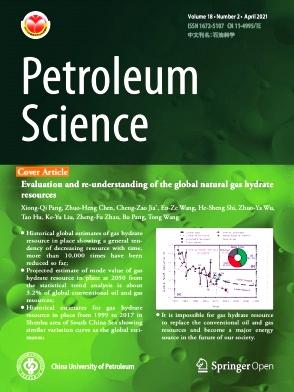变形多尺度缝孔介质中气水两相流动孔隙网络建模
IF 6.1
1区 工程技术
Q2 ENERGY & FUELS
引用次数: 0
摘要
选取塔里木盆地某典型超深层油气储层实测岩石,进行原位应力加载微焦点CT扫描实验。得到了不同应力加载阶段岩石微观结构的灰度图像。基于深部岩石CT切片图像,利用U-Net全卷积神经网络实现岩石骨架、孔隙空间和微裂缝的精细语义分割。在此基础上,对不同应力加载阶段变形多尺度缝孔介质三维数字岩石模型进行重构,最终提取等效缝孔网络模型,探索孔隙尺度下气水两相流动的潜在机理。结果表明,在地应力加载过程中,深部岩石均经历了线弹性变形、非线性塑性变形和剪切破坏三个阶段。岩石微观力学行为对岩石微观结构的动态变形和气水两相流动有很大影响。在线弹性变形阶段,随着地应力的增大,深部岩石均逐渐被压实,导致平均孔隙半径、孔喉比、弯曲度和水相相对渗透率降低,配位数基本保持不变。在塑性变形阶段,岩石压实作用和微裂缝存在的协同作用对孔喉拓扑性质和气水相对渗透率有较大影响。在剪切破坏阶段,深层岩石内部由于微裂缝的产生和扩展,拓扑连通性变好,流体流道增加,导流性提高,导致平均孔隙半径和配位数急剧增大,孔喉比和弯曲度迅速减小,气相和水相相对渗透率显著提高。本文章由计算机程序翻译,如有差异,请以英文原文为准。
Pore network modeling of gas–water two-phase flow in deformed multi-scale fracture-porous media
Two actual rocks drilled from a typical ultra-deep hydrocarbon reservoir in the Tarim Basin are selected to conduct in-situ stress-loading micro-focus CT scanning experiments. The gray images of rock microstructure at different stress loading stages are obtained. The U-Net fully convolutional neural network is utilized to achieve fine semantic segmentation of rock skeleton, pore space, and micro-fractures based on CT slice images of deep rocks. The three-dimensional digital rock models of deformed multiscale fractured-porous media at different stress loading stages are thereafter reconstructed, and the equivalent fracture-pore network models are finally extracted to explore the underlying mechanisms of gas–water two-phase flow at the pore-scale. Results indicate that, in the process of in-situ stress loading, both the deep rocks have experienced three stages: linear elastic deformation, nonlinear plastic deformation, and shear failure. The micro-mechanical behavior greatly affects the dynamic deformation of rock microstructure and gas–water two-phase flow. In the linear elastic deformation stage, with the increase in in-situ stress, both the deep rocks are gradually compacted, leading to decreases in average pore radius, pore throat ratio, tortuosity, and water-phase relative permeability, while the coordination number nearly remains unchanged. In the plastic deformation stage, the synergistic influence of rock compaction and existence of micro-fractures typically exert a great effect on pore-throat topological properties and gas–water relative permeability. In the shear failure stage, due to the generation and propagation of micro-fractures inside the deep rock, the topological connectivity becomes better, fluid flow paths increase, and flow conductivity is promoted, thus leading to sharp increases in average pore radius and coordination number, rapid decreases in pore throat ratio and tortuosity, as well as remarkable improvement in relative permeability of gas phase and water phase.
求助全文
通过发布文献求助,成功后即可免费获取论文全文。
去求助
来源期刊

Petroleum Science
地学-地球化学与地球物理
CiteScore
7.70
自引率
16.10%
发文量
311
审稿时长
63 days
期刊介绍:
Petroleum Science is the only English journal in China on petroleum science and technology that is intended for professionals engaged in petroleum science research and technical applications all over the world, as well as the managerial personnel of oil companies. It covers petroleum geology, petroleum geophysics, petroleum engineering, petrochemistry & chemical engineering, petroleum mechanics, and economic management. It aims to introduce the latest results in oil industry research in China, promote cooperation in petroleum science research between China and the rest of the world, and build a bridge for scientific communication between China and the world.
 求助内容:
求助内容: 应助结果提醒方式:
应助结果提醒方式:


